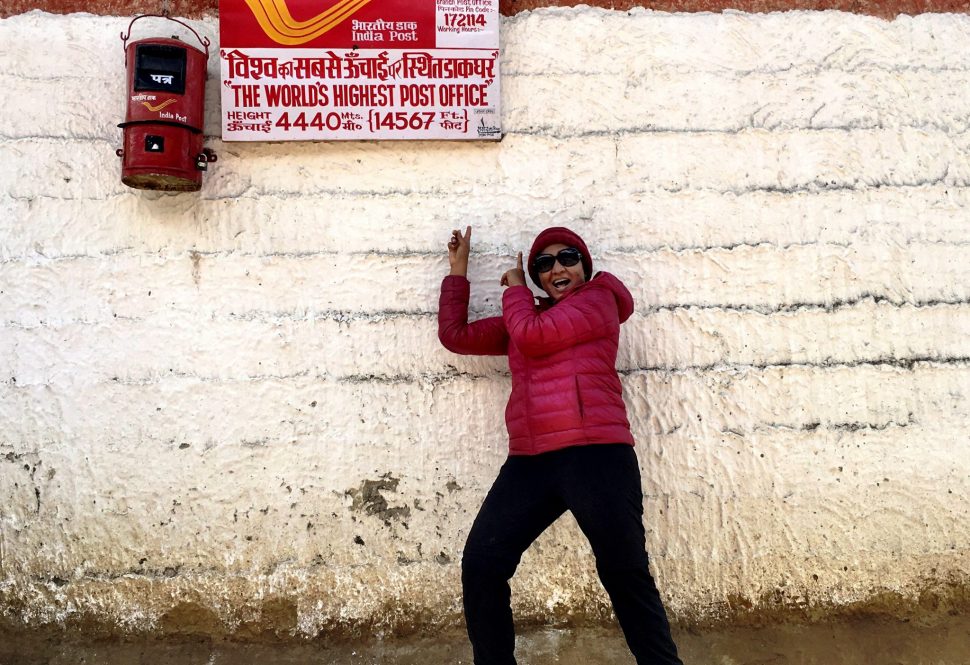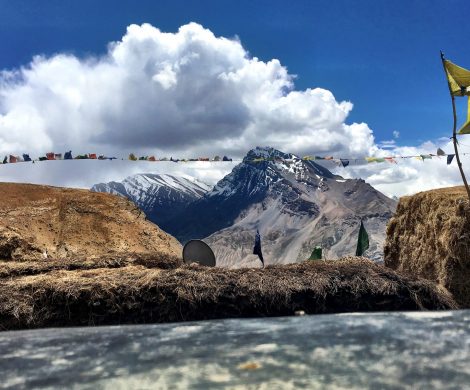
Hikkim is about an hour before Komic, the highest village in Asia. (I took an hour. Locals do it in 15 mins). The post office is an unassuming mud structure painted in white, which also doubles up as the home of the Post Master Rinchen Chhering, who has held that position for the last 30 years since the PO was established in Hikkim. Chhering explained that he started this job at the age of 22, and he was chosen for it specifically because he had a bicycle and could run fast!

It’s just another home in this tiny village of 25 households, which is only distinguished by the board hanging outside proclaiming its significance, and the horde of trekkers and tourists who show up to take photos of the place. The sign board says the altitude is 14567 feet, but Chhering insists the altitude is 15500 feet.
For 6 months of the year, the Spiti Valley is cut off from the rest of the world when the only two roads connecting to it are snowed in during winters. The post office, which is the only mode of communication for the residents of Hikkim which gets no cell phone reception (internet…what’s that?), is also closed during winters.

Side note — Hikkim also holds the honour of being the highest polling booth in the world!
I was fascinated by the process Chhering described as to how mail is distributed from Hikkim. Two runners take turns in carrying mail on foot from Hikkim to Kaza, 23 kms away, every morning. Kaza is the administrative HQ of Spiti and the closest thing to a town in the valley.
From Kaza, mail bags are taken by bus to Reckong Peo, the headquarters of Kinnaur district and then to Shimla. From here it’s moved to a train to Kalka, a sleepy little town in Haryana, then loaded on to a bus again headed to Delhi. At Delhi, mail is sorted and distributed onwards by train or plane depending on destination. The first part of the mail journey is what amazes me the most. The 23 km daily trek to Kaza is nothing more than a quick one hour walk for Spitians ! The locals walk up steep ascents like they are casually strolling down a garden path on the plains.
By the time I reached Hikkim on my first trek, I was exhausted. The opportunity to sit down and write a postcard while resting my tired feet was welcome. I had bought 3 postcards in Kaza just for this purpose. Chhering told us that in the last 5-6 years he is having to send between 150-200 postcards a day from curious visitors to the highest PO in the world. He has no employees or assistance. The world’s highest post office is a one man operation.
Lest you think that the only business conducted at this post office involves letters and postcards from tourists, this is also where local farmers maintain a savings account. Monks from the historic Komic monastery receive their passports here, needed for their travels to Buddhist monasteries abroad.
I perched on a ladder leaning outside the post office to write my postcards, while Cherring’s son and daughter played a game of badminton outside, unfazed by the continuous stream of visitors.
I was at Hikkim post office on June 10, 2017. Two postcards were sent to California and one to Bangalore. It’s been a little more than two weeks and none of them has made it to their destination yet. But there’s no hurry. I feel like I time travelled to a bygone era when I was in Spiti when things were simpler, slower, and less stressful. Let my postcards make their journey through time, in their own time.


